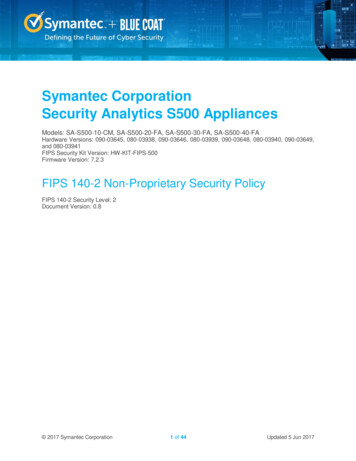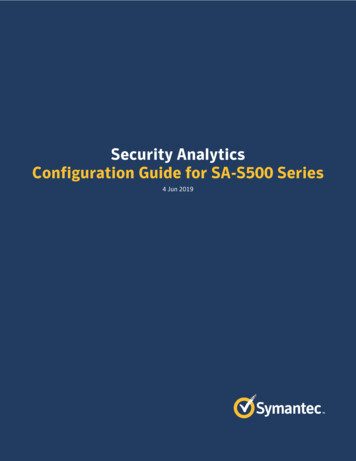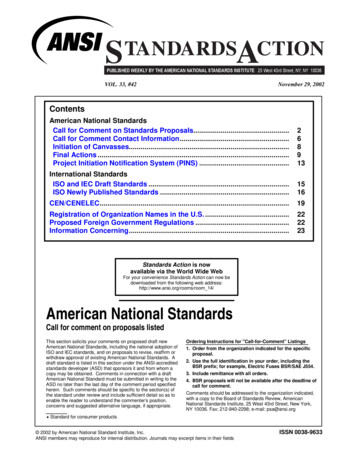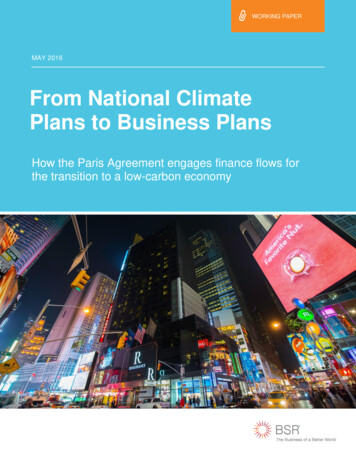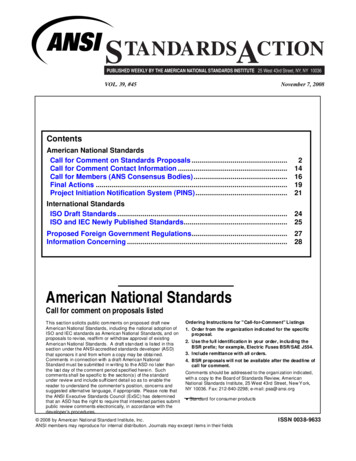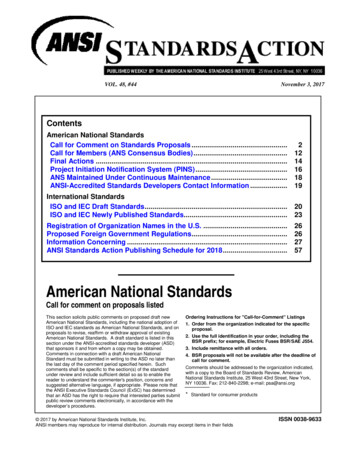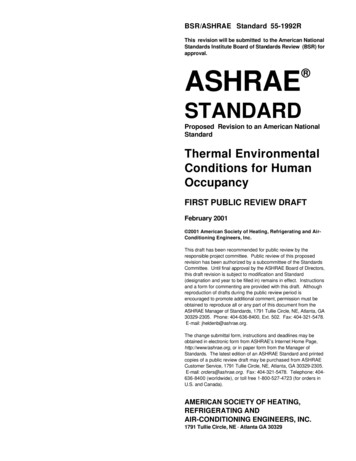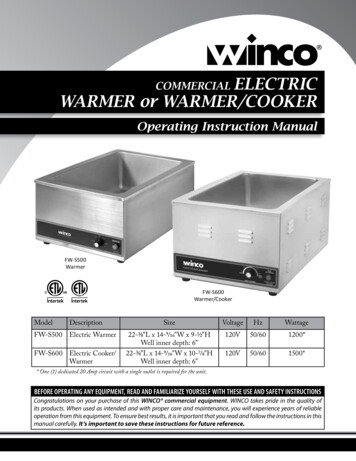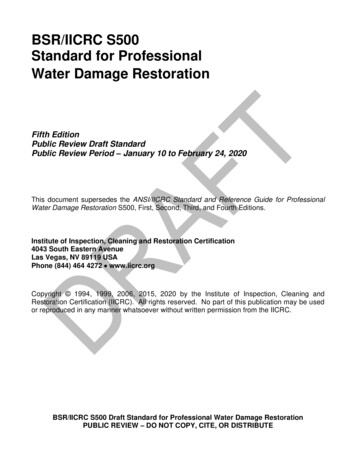
Transcription
BSR/IICRC S500Standard for ProfessionalWater Damage RestorationFifth EditionPublic Review Draft StandardPublic Review Period – January 10 to February 24, 2020This document supersedes the ANSI/IICRC Standard and Reference Guide for ProfessionalWater Damage Restoration S500, First, Second, Third, and Fourth Editions.Institute of Inspection, Cleaning and Restoration Certification4043 South Eastern AvenueLas Vegas, NV 89119 USAPhone (844) 464 4272 www.iicrc.orgCopyright 1994, 1999, 2006, 2015, 2020 by the Institute of Inspection, Cleaning andRestoration Certification (IICRC). All rights reserved. No part of this publication may be usedor reproduced in any manner whatsoever without written permission from the IICRC.BSR/IICRC S500 Draft Standard for Professional Water Damage RestorationPUBLIC REVIEW – DO NOT COPY, CITE, OR DISTRIBUTE
Table of ContentsBSR/IICRC S500 Standard SectionsImportant Definitions . 3Section AScope, Purpose, and Application . 4Section BDefinitions . 5Section 1Principles of Water Damage Restoration. 12Section 2Microbiology of Water Damage . 14Section 3Health Effects from Exposure to Microbial Contamination in Water-DamagedBuildings . 15Section 4Building and Material Science . 16Section 5Psychrometry and Drying Technology . 17Section 6Equipment, Instruments, and Tools . 17Section 7Antimicrobial (biocide) Technology . 17Section 8Safety and Health . 18Section 9Administrative Procedures, Project Documentation and Risk Management . 25Section 10Inspections, Preliminary Determination, and Pre-Restoration Evaluations . 30Section 11Limitations, Complexities, Complications and Conflicts . 38Section 12Structural Restoration . 41Section 13Heating, Ventilating and Air Conditioning Restoration . 54Section 14Contents Evaluation and Restoration . 58Section 15Large or Catastrophic Restoration Projects. 69Section 16Materials and Assemblies . 7512BSR/IICRC S500 Draft Standard for Professional Water Damage RestorationPUBLIC REVIEW – DO NOT COPY, CITE, OR DISTRIBUTE
Institute of Inspection, Cleaning and Restoration 24252627282930313233343536BSR/IICRC S500: 2020Important DefinitionsThroughout this document the terms “shall,” should,” and “recommend” are used to compare andcontrast the different levels of importance attached to certain practices and procedures.shall: when the term shall is used in this document, it means that the practice or procedure is mandatorydue to natural law or regulatory requirement, including occupational, public health and other relevantlaws, rules or regulations, and is therefore a component of the accepted “standard of care” to befollowed.should: when the term should is used in this document, it means that the practice or procedure is acomponent of the accepted “standard of care” to be followed, while not mandatory by regulatoryrequirements.recommend(ed): when the term recommend(ed) is used in this document, it means that the practiceor procedure is advised or suggested but is not a component of the accepted “standard of care” to befollowed.In addition, the terms “may” and “can” are also available to describe referenced practices or procedures,and are defined as follows:may: when the term may is used in this document, it signifies permission expressed by the document, andmeans that a referenced practice or procedure is permissible within the limits of this document, but is not acomponent of the accepted “standard of care” to be followed.can: when the term can is used in this document, it signifies an ability or possibility open to a user of thedocument, and it means that a referenced practice or procedure is possible or capable of application, butis not a component of the accepted “standard of care” to be followed.For the practical purposes of this document, it was deemed appropriate to highlight and distinguish thecritical restoration methods and procedures from the less critical, by characterizing the former as the“standard of care.” The IICRC S500 consensus body standard committee interprets the “standard of care”to be: practices that are common to reasonably prudent members of the trade who are recognized in theindustry as qualified and competent. Notwithstanding the foregoing, this Standard is not intended to beeither exhaustive or inclusive of all pertinent requirements, methods or procedures that might be appropriateon a particular water damage restoration project.373BSR/IICRC S500 Draft Standard for Professional Water Damage RestorationPUBLIC REVIEW – DO NOT COPY, CITE, OR DISTRIBUTE
Institute of Inspection, Cleaning and Restoration 4950515253AScope, Purpose and ApplicationA.1ScopeBSR/IICRC S500: 2020This Standard describes the procedures to be followed and the precautions to be taken when performingwater damage restoration in residential, commercial and institutional buildings, and the systems andpersonal property contained within those structures.This Standard assumes that the determination and correction of the underlying source or cause of the waterintrusion leading to the water damage is the responsibility of the property owner and not the restorer,although the property owner may contract with the restorer or other specialized experts to perform theseservices.Water damage restoration consists of the following components for which procedures are described in thisStandard: A.2Principles of Water Damage RestorationMicrobiology of Water DamageHealth Effects from Exposure to Microbial Contamination in Water-Damaged BuildingsBuilding and Material SciencePsychrometry and Drying TechnologyEquipment, Instruments, and ToolsAntimicrobial (biocide) TechnologySafety and HealthAdministrative Procedures, Project Documentation and Risk ManagementInspections, Preliminary Determinations and Pre-Restoration EvaluationsLimitations, Complications, Complexities and ConflictsSpecialized ExpertsStructural RestorationHeating, Ventilating and Air Conditioning (HVAC) RestorationContents Evaluation, Restoration and RemediationLarge or Catastrophic Restoration ProjectsMaterials and AssembliesPurposeIt is the purpose of this Standard to define criteria and methodology used by the restorer for inspecting andinvestigating water damage and associated contamination, and for establishing water damage restorationwork plans and procedures.This Standard is not intended to be either exhaustive or inclusive of all pertinent requirements, methods orprocedures that might be appropriate on a particular water damage restoration project. Restorers shoulduse professional judgment throughout each and every project. However, the use of professional judgmentis not a license to not comply with this standard. A project might have unique circumstances that mayinfrequently allow for a deviation from the standard. Prior to deviation from the standard of care (i.e., “shall”or “should”) the restorer should document the circumstances that led to such a decision, notify the materiallyinterested parties, and in the absence of a timely objection, document the communication beforeproceeding.This Standard does not specifically address the protocols and procedures for restoration when potentiallyhazardous, regulated materials are present or likely to be present in water-damaged structures, systemsand contents. Such potentially hazardous, regulated materials include, but are not limited to: asbestos,lead, arsenic, mercury, polychlorinated biphenyls (PCBs), pesticides, fuels, solvents, radiological residues,and other chemical and certain biological contaminants.4BSR/IICRC S500 Draft Standard for Professional Water Damage RestorationPUBLIC REVIEW – DO NOT COPY, CITE, OR DISTRIBUTE
Institute of Inspection, Cleaning and Restoration 495051525354A.3BSR/IICRC S500: 2020ApplicationThis Standard was written for use by those involved in the water damage restoration industry, primarily forrestoration companies and workers, and secondarily, for others who investigate or assess abnormal waterintrusion, prepare restoration specifications and procedures and protocols, and manage restorationprojects, (e.g., indoor environmental professionals (IEPs), and other specialized experts) and finally, forother potential materially interested parties (e.g., consumers and occupants, property owners andmanagers, government and regulatory bodies, insurance company representatives, or third partyadministrators).B.DefinitionsCertain terms and definitions associated with water damage restoration exist. The following are definitionsof terms used in this standard:affected area: an area of a structure that has been impacted by primary or secondary damage.air: a simple mixture of gases (e.g., nitrogen, oxygen, water vapor, carbon dioxide) that surrounds theEarth; a space that is filled with air.airflow: air movement, whether uncontrolled or controlled (managed). Two commonly used airflowmeasurements are volumetric flow (e.g., cubic feet per minute) and velocity (e.g., feet per minute).airmover: an air moving device typically designed for or used in the professional water damage restorationindustry.assessment: a process performed by an indoor environmental professional (IEP) that includes theevaluation of data obtained from a building history and inspection to formulate an initial hypothesis aboutthe origin, identity, location and extent of contamination. If necessary, a sampling plan is developed, andsamples are collected and sent to a qualified laboratory for analysis. The subsequent data is interpreted bythe IEP. Then, the IEP, or other qualified individual, may develop a remediation plan. See also evaluation.bound water: moisture held within the cellular or crystalline structure of the material. This moisture maybe sorbed into the cells or can become physically or chemically bound to the surfaces of cells. Some of thismoisture is always present in the material and does not need to be removed. In fact, much of the boundwater in concrete is a critical part of the hydration process and actually strengthens it. A certain amount ofbound water in wood is also desirable, contributing to its dimensional stability and strength.boundary layer: a thin layer of air at the surface of materials that due to surface friction does not move atthe full speed of the surrounding airflow. The effect of this lack of airflow retards water evaporation at thesurface and heat transfer to the materials. Directing sufficient and continuous air at material surfacesminimizes this boundary layer, removes evaporated water, and aids in transferring thermal energy to thesurface of materials.Category of Water: the categories of water, as defined by this document, refer to the range ofcontamination in water, considering both its originating source and quality after it contacts materials presenton the job site. Time and temperature can affect or retard the amplification of contaminants, therebyaffecting its category. Restorers should consider potential contamination, defined as the presence ofundesired substances; the identity, location and quantity of which are not reflective of a normal indoorenvironment; and can produce adverse health effects, cause damage to structure and contents or adverselyaffect the operation or function of building systems.5BSR/IICRC S500 Draft Standard for Professional Water Damage RestorationPUBLIC REVIEW – DO NOT COPY, CITE, OR DISTRIBUTE
Institute of Inspection, Cleaning and Restoration 495051525354BSR/IICRC S500: 2020Category 1: Category 1 water originates from a sanitary water source and does not posesubstantial risk from dermal, ingestion, or inhalation exposure. Examples of Category 1 watersources can include, but are not limited to: broken water supply lines; tub or sink overflows with nocontaminants; appliance malfunctions involving water-supply lines; melting ice or snow; fallingrainwater; broken toilet tanks, and toilet bowls that do not contain contaminants or additives.Category 1 water can deteriorate to Category 2 or 3. Category 1 water that flows into anuncontaminated building does not constitute an immediate change in the category. However,Category 1 water that flows into a contaminated building can constitute an immediate change inthe category. Once microorganisms become wet from the water intrusion, depending upon thelength of time that they remain wet and the temperature, they can begin to grow in numbers andcan change the category of the water. Odors can indicate that Category 1 water has deteriorated.Category 2: Category 2 water contains significant contamination and has the potential to causediscomfort or sickness if contacted or consumed by humans. Category 2 water can containpotentially unsafe levels of microorganisms or nutrients for microorganisms, as well as otherorganic or inorganic matter (chemical or biological). Examples of category 2 water can include, butare not limited to: discharge from dishwashers or washing machines; overflows from washingmachines; overflows from toilet bowls on the room side of the trap with some urine but no feces;seepage due to hydrostatic pressure; broken aquariums and punctured water beds.Category 2 water can deteriorate to Category 3. Once microorganisms become wet from the waterintrusion, depending upon the length of time that they remain wet and the temperature, they canbegin to grow in numbers and can change the category of the water.Category 3: Category 3 water is grossly contaminated and can contain pathogenic, toxigenic orother harmful agents and can cause significant adverse reactions to humans if contacted orconsumed. Examples of Category 3 water can include, but are not limited to: sewage; wastelinebackflows that originate from beyond any trap regardless of visible content or color; all forms offlooding from seawater; rising water from rivers or streams; and other contaminated water enteringor affecting the indoor environment, such as wind-driven rain from hurricanes, tropical storms, orother weather-related events. Category 3 water can carry trace levels of regulated or hazardousmaterials (e.g., pesticides, or toxic organic substances).Regulated, hazardous materials, and mold: if a regulated or hazardous material is part of awater damage restoration project, then a specialized expert may be necessary to assist in damageassessment. Restorers shall comply with applicable federal, state, provincial and local laws andregulations. Regulated materials posing potential or recognized health risks can include, but arenot limited to: arsenic, mercury, lead, asbestos, polychlorinated biphenyls (PCBs), ethylene glycol,pesticides, fuels, solvents, caustic chemicals and radiological residues. For situations involvingvisible or suspected mold, refer to the current version of ANSI/IICRC S520 Standard forProfessional Mold Remediation. Qualified persons shall abate regulated materials, or shouldremediate mold prior to restorative drying.Class of water intrusion: a classification of the estimated evaporation load; is used when calculating theinitial humidity control (e.g., dehumidification, ventilation). The classification is based on the approximateamount of wet surface area, and the permeance and porosity of affected materials remaining within thedrying environment at the time drying is initiated. Information needed to determine Class should be gatheredduring the inspection process. The Classes are divided into four separate descriptions, Class 1, 2, 3, and4.Class 1 — (least amount of water absorption and evaporation load): Water intrusion where wet,porous materials (e.g., carpet, gypsum board, fiber-fill insulation, concrete masonry unit (CMU),6BSR/IICRC S500 Draft Standard for Professional Water Damage RestorationPUBLIC REVIEW – DO NOT COPY, CITE, OR DISTRIBUTE
Institute of Inspection, Cleaning and Restoration 495051525354BSR/IICRC S500: 2020textiles) represent less than 5% of the combined floor, wall and ceiling surface area in the space;and where materials described as low evaporation materials (e.g., plaster, wood, concrete,masonry) or low evaporation assemblies (e.g., multilayer wallboard, multilayer subfloors, gymfloors, or other complex, built-up assemblies) have absorbed minimal moisture.Class 2 — (significant amount of water absorption and evaporation load): water intrusion wherewet, porous materials (e.g., carpet, gypsum board, fiber-fill insulation, concrete masonry unit(CMU), textiles) represent 5% to 40% of the combined floor, wall and ceiling surface area in thespace; and where materials described as low evaporation materials (e.g., plaster, wood, concrete,masonry) or low evaporation assemblies (e.g., multilayer wallboard, multilayer subfloors, gymfloors, or other complex, built-up assemblies) have absorbed minimal moisture.Class 3 — (greatest amount of water absorption and evaporation load): water intrusion where wet,porous materials (e.g., carpet, gypsum board, fiber-fill insulation, concrete masonry unit (CMU),textiles) represent more than 40% of the combined floor, wall and ceiling surface area in thespace; and where materials described as low evaporation materials (e.g., plaster, wood, concrete,masonry) or low evaporation assemblies (e.g., multilayer wallboard, multilayer subfloors, gymfloors, or other complex, built-up assemblies) have absorbed minimal moisture.Class 4 — (deeply held or bound water): water intrusion that involves a significant amount of waterabsorption into low evaporation materials (e.g., plaster, wood, concrete, masonry) or lowevaporation assemblies (e.g., multilayer wallboard, multilayer subfloors, gym floors, or othercomplex, built-up assemblies). Drying may require special methods, longer drying times, orsubstantial water vapor pressure differentials.cleaning: the process of containing, removing and properly disposing of unwanted substances from anenvironment or material.contamination, contaminated: the presence of undesired substances; the identity, location and quantityof which are not reflective of a normal indoor environment, and can produce adverse health effects, causedamage to structure and contents or adversely affect the operation or function of building systems.cross-contamination: the spread of contaminants from a contaminated area to an uncontaminated area.damage, primary: the wetting or impairment of the appearance or function of a material from directexposure to water or contamination carried by the water which is reversible or permanent. Primary damagedoes not include water damage as a result of tracking or that is otherwise spread.damage, secondary: the wetting or impairment of the appearance or function of a material from indirectexposure to water or contamination carried by the water which is reversible or permanent. Examples ofsecondary damage can include: absorbed moisture or humidity, microbial growth, and acid residuediscoloration. See "primary damage"damage, pre-existing: the impairment of the appearance or function of a material from direct or indirectexposure to water or other conditions not related to the current water intrusion. Examples of pre-existingdamage can include: dry rot, urine contamination, and mold growth.dehumidification: the process of removing moisture from air.dew point temperature: the temperature at which humidity in a parcel of air reaches the saturation point(100% RH), below which water vapor will condense from that air to form condensation on surfaces orparticles.disinfectant: irreversibly inactivates pathogenic (e.g., infectious) microorganisms on inanimate objects, but7BSR/IICRC S500 Draft Standard for Professional Water Damage RestorationPUBLIC REVIEW – DO NOT COPY, CITE, OR DISTRIBUTE
Institute of Inspection, Cleaning and Restoration 49505152BSR/IICRC S500: 2020not necessarily their spores. Effectively destroys 99.999% of target organisms.drying: the process of removing moisture from materials.drying plan: A subsection of a work plan, the drying plan is a restorer developed and implemented planthat establishes target ranges, means and methods for controlling humidity, temperature, and airflow toachieve the drying goals, and in accordance with project LCCCs.dry standard: a reasonable approximation of the moisture content or level of a material prior to a waterintrusion. An acceptable method is to determine the moisture content or levels of similar materials inunaffected areas or use historical data for the region.drying environment: a controlled environment in which evaporation from damp or wet materials isencouraged, leading to an accelerated reduction in their moisture level or moisture content.drying goal: the target moisture content or moisture level in a material to be achieved at the end of thedrying process that is based on the dry standard and is established by the restorer.engineering controls: utilization of equipment or physical barriers to prevent or significantly minimizeexposure of workers, occupants, and unaffected areas and contents to recognized hazards (e.g.,contaminants, electrical circuits, falling debris).equilibrium moisture content (EMC): the moisture content at which a material neither gains nor losesmoisture when surrounded by air at a given relative humidity and temperature.evaluation: a process completed by the restorer or specialized expert to gather and consider information.See also pre-restoration evaluation, pre-remediation evaluation, assessment.evaporation: the process of changing a liquid to a vapor.evaporation load: the anticipated amount of water vapor added to a drying environment by means ofevaporation from wet materials. Evaporation load is affected by several factors, including concentration ofmoisture in the air, water vapor pressures of wet materials, temperature of wet materials, air movementacross wet surfaces and access to wet materials.flood (flooded, flooding): an overflowing of a large amount of water beyond its normal confines inundatingan area that would normally be dry land.free water: liquid moisture on the surface and held in the pores of the material. All of this is excess moisturethat has been drawn into the materials through capillary action. As free water remains, the cell material willabsorb the moisture, thus becoming bound water until the point of fiber saturation. In most cellulose-basedproducts, (e.g., wood, paper) this fiber saturation point is between 25-30% MC. All free water needs to beremoved during the restorative drying process.humidity: an expression of water vapor in air. Two common measurements used in this document arehumidity ratio and relative humidity. Note: In this document, when the term humidity is used withoutqualification, it will refer to the humidity ratio of the air, one of the absolute measures of the amount ofmoisture present.humidity control – removing water vapor from air at an equal or greater rate than evaporated from wetmaterials to minimize moisture migration, potential secondary damage, and microbial amplification.8BSR/IICRC S500 Draft Standard for Professional Water Damage RestorationPUBLIC REVIEW – DO NOT COPY, CITE, OR DISTRIBUTE
Institute of Inspection, Cleaning and Restoration 49505152535455BSR/IICRC S500: 2020humidity ratio (HR) (alternatively, vapor content or mixing ratio): the humidity ratio of a given moist airsample is defined as the ratio of the mass of water vapor to the mass of dry air in the sample. It is expressedin grains per pound (grams per kilogram) of dry air, sometimes shortened to gr/lb or gpp (g/kg).HR Weightwater vapor / (Weightmoist air – Weightwater vapor) or Weightwater vapor / Weightdry airNote: In this document, when the term humidity is used without qualification, it will refer to the humidity ratioof the air, one of the absolute measures of the amount of moisture present.indoor environmental professional (IEP): an individual with the education, training and experience toperform an assessment of the microbial ecology of structure, systems and contents at a job site, create asampling strategy, sample the indoor environment and submit to an appropriate laboratory, interpretlaboratory data and determine Category of water or Condition 1, 2, and 3 for the purpose of establishing ascope of work and verifying the return to a normal microbial ecology (e.g., Condition 1). The term IEP(other terms or titles )inspection: the process of gathering information needed to determine the category, condition, class, orstatus of a water intrusion, building material, assembly or system.Institute of Inspection, Cleaning and Restoration Certification (IICRC): an international, non-profit,certification and standard setting organization providing certification through education for the professionalinspection, cleaning, restoration and remediation service industries: web page - www.iicrc.org.low evaporation assemblies: assemblies that due to their construction exhibit similar qualities to lowevaporation materials (absorbs or transmits water slowly). Low evaporation assemblies may include, butnot be limited to multilayer wallboard, multilayer subfloors, gym floors, or other complex, built-upassemblies. See low evaporation materials.low evaporation materials: materials that due to their porosity, permeance or internal structure have alow sorptivity (absorbs or transmits water slowly). Low evaporation materials may include but not be limitedto plaster, wood, concrete, and masonry.materially interested parties: an individual or entity substantially and directly affected by the waterdamage restoration project.microorganism (microbe): an extremely small organism that usually is visible only with the aid of amicroscope (e.g., protozoa, algae, bacteria, fungi, virus).mitigate, mitigation: to reduce or minimize further damage to structure, contents and systems in the builtenvironment by controlling the spread of contamination and moisture.moisture content: the measurement of the amount of moisture contained in a material, expressed as apercentage of the weight of the oven-dry material. In regards to measurements, it is only recommendedthat the term “moisture content” be used when such measurements are taken using instruments calibratedfor the given material and material temperature.moisture level: the measurement of the amount of moisture contained in a material on a relative scale. Ifa restorer is measuring materials with an instrument that is not calibrated for that material, then it isrecommended that the term moisture level be used.moisture map: documentation that visually indicates the extent of water migration in the structure bycommunicating the area(s) affected and immediately adjacent unaffected area(s).moisture meter: a device used to measure the moisture level or moisture content of a material.moisture sensor: a device that indicates bulk moisture potentially present in a material, but does notprovide a numerical reading to indicate the amount of moisture present.9BSR/IICRC S500 Draft Standard for Professional Water Damage RestorationPUBLIC REVIEW – DO NOT COPY, CITE, OR DISTRIBUTE
Institute of Inspection, Cleaning and Restoration 49505152535455BSR/IICRC S500: 2020monitoring: the process of observing and documenting the change in a project variable over time, suchas a moisture level or psychrometric value (e.g., temperature, humidity).post-remediation verification: an inspection and assessment performed by an IEP after a remediationproject, which can include visual inspection, odor detection, analytical testing or environmental samplingmethodologies to verify that the structure, system or contents have been returned to a Category 1 oruncontaminated level.post-remediation evaluation: process performed by the restorer to determine that the structure, systemor contents have been returned to a Category 1 or uncontaminated level.pre-remediation assessment: the determination by an IEP of category 1, 2 or 3 status for the purpose ofestablishing a scope of work.pre-remediation evaluation: process performed by the restorer to establish the category of water for thepurpose o
Institute of Inspection, Cleaning and Restoration Certification BSR/IICRC S500: 2020 BSR/IICRC S500 Draft Standard for Professional Water Damage Restoration PUBLIC REVIEW - DO NOT COPY, CITE, OR DISTRIBUTE - DO NOT COPY, CITE, OR DISTRIBUTE — — —
